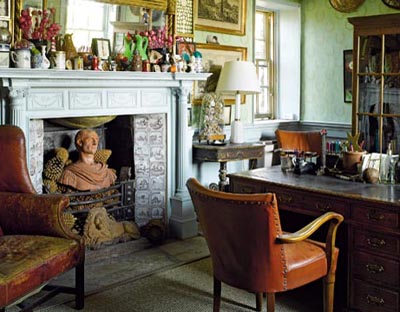Dream Room: The Study
The study is a sanctuary of peace and quiet which individuals make entirely their own, although a desk, light source and a comfortable chair are prerequisites

On paper, it sounds so simple: a room that demands only a well-lit desk and a comfortable chair. But the study of our dreams does more than provide a surface for writing and lamps for reading: it offers a whole-hearted affirmation of its owner's deepest core. Its purpose may be wide ranging-from full-scale research projects to a surreptitious cigarette snatched over a glass of whisky as you catch up on the racing results on iPlayer.
In each case, the perfect study embraces concepts of sanctuary, as remote from domestic bustle as the gunrooms and boudoirs of a vanished generation. Whoever its owner, it should inspire possessiveness, as much a part of one as a favourite rain hat and those photographs of deceased pets whose value no one else can guess.
A study is an intimate space, regardless of its size. To the outside world, it may resemble a full-scale library, but it contains within itself corners and recesses perfectly condu-cive to contemplation or catnapping. Even airy, modern studies, where a laptop, iPhone and printer alone disturb the streamlined surfaces, encode an idea of privacy, as if the visitor has stumbled on his host's ablutions. But this isn't a selfish room: the dogbed beside the bookcase is proof of shared ownership.

It's an enclave of books and busts and silver-mounted blotters and bottles all jumbled on to a butler's tray the household's lesser drinks table. Its surfaces sport photographs in frames and piles of magazines. On the floor, a Ziegler carpet too worn for use elsewhere contributes all the colours of old Persia. Its labyrinthine pattern and a suggestion of exotic hi-jinks lifted straight from the novels of Agatha Christie may be as near to adventure as the room's owner ever ventures. Whether the room is on the ground or first floor, there will be a view over the garden or the street beyond, a visual reminder that all work and no play makes Jack a dull boy.
The perfect study is neither stereo-typically masculine nor feminine in appearance: it simply reiterates something of its owner's character. It may double as a cosy sitting room home to television, an iPod docking system, a cupboard full of games; as such it requires comfortable sofas and chairs, well-lined curtains or working shutters, small tables and lamps.
Alternatively, it's a home office, and its furniture, be it a Louis XV bureau plat or a Conran trestle table, peaceably coexists with current technology and all the paraphernalia of modern communications and networking. Only the room's smell tells you that this is not a commercial space-the tang of new leaves in the garden outside, a tower of newspapers awaiting recycling, old pot pourri or the owner's scent applied day after day, year in year out, infiltrating curtains, cushions, even the very pages of the books that crowd the shelves.
In houses with a young family, children's artwork may overspill the kitchen into the study. Perhaps the carpet betrays past accidents of small children or new puppies. Intimations of life lived, like the impress of a body in a cushion, define this room. When the door is closed, the study shrinks to a table, a chair and a light source.
Sign up for the Country Life Newsletter
Exquisite houses, the beauty of Nature, and how to get the most from your life, straight to your inbox.
The chair combines comfort with proper support, the table is generously sized and of the right height, the light source is practical but beautiful, whether an antique toleware bouillotte wired for electricity or the lifesize Horse floor lamp designed by Front for Moooi. It illuminates work in progress with-out emphasising the siren allure of those piles of waiting books or last year's damson vodka still unopened on the drinks tray.
Country Life is unlike any other magazine: the only glossy weekly on the newsstand and the only magazine that has been guest-edited by HRH The King not once, but twice. It is a celebration of modern rural life and all its diverse joys and pleasures — that was first published in Queen Victoria's Diamond Jubilee year. Our eclectic mixture of witty and informative content — from the most up-to-date property news and commentary and a coveted glimpse inside some of the UK's best houses and gardens, to gardening, the arts and interior design, written by experts in their field — still cannot be found in print or online, anywhere else.
-
 380 acres and 90 bedrooms on the £25m private island being sold by one of Britain's top music producers
380 acres and 90 bedrooms on the £25m private island being sold by one of Britain's top music producersStormzy, Rihanna and the Rolling Stones are just a part of the story at Osea Island, a dot on the map in the seas off Essex.
By Lotte Brundle
-
 'A delicious chance to step back in time and bask in the best of Britain': An insider's guide to The Season
'A delicious chance to step back in time and bask in the best of Britain': An insider's guide to The SeasonHere's how to navigate this summer's top events in style, from those who know best.
By Madeleine Silver